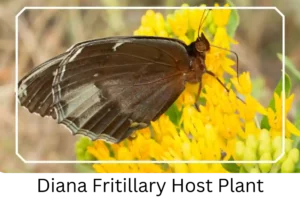Diana Fritillary (Speyeria diana)
The Diana Fritillary, scientifically recognized as a vibrant species within the butterfly kingdom, graces the North American continent with its presence, particularly thriving within the Arkansas valley. This butterfly species is celebrated not only for its striking appearance but also for its unique life cycle and behaviors that distinguish it from its counterparts.
Scientific Classification
- Family: Nymphalidae
- Genus: Speyeria
- Common names: Diana Butterfly
- Scientific Name: Speyeria diana
Overview
Characterized by its bright orange coloration and distinctive life stages, the Diana Fritillary embodies the rich biodiversity found within its native habitats. From its initial phase as a caterpillar to its transformation into a breathtaking adult butterfly, each stage of its life cycle reveals nature’s intricacies. This species, a subject of admiration and study, serves as a vital component of the ecosystems it inhabits, pollinating plants and contributing to the ecological balance.
Description and Identification
Caterpillar
The Diana Fritillary Caterpillar emerges before the winter, embarking on a journey of growth by feeding on the leaves of its host plants. Its appearance is marked by a striking contrast of either a completely black or blackish-brown body adorned with yellow dots and lines, along with thorny projections along the dorsal side, a testament to nature’s defense mechanisms.
Pupa
With the onset of winter, the caterpillar retreats into the soil, undergoing a remarkable transformation into a chrysalis that ranges in color from black to brown-black. This stage is a critical part of its metamorphosis, culminating in the emergence of the adult butterfly in the spring, a moment that signals the continuation of its species.
Adult Butterfly
Sexual Dimorphism: The Diana Fritillary showcases a clear distinction between males and females, a phenomenon known as sexual dimorphism. This differentiation is not only evident in their size, with females generally larger than males but also in their coloration and patterns, which play a significant role in their identification.
Color and Appearance: While the males boast broad orange borders on their wings, visible when spread, and a burnt orange hue when closed, the females display a striking dark blue on the dorsal side, contrasting with a dusty grayish tone on the ventral side. This vivid coloration not only adds to their aesthetic appeal but also serves as a means of camouflage and mate attraction.

 Average Wingspan: The Diana Fritillary spans an impressive range of 3.42 to 4.44 inches (8.7 to 11.3 cm), a size that facilitates their fast and agile flight patterns.
Average Wingspan: The Diana Fritillary spans an impressive range of 3.42 to 4.44 inches (8.7 to 11.3 cm), a size that facilitates their fast and agile flight patterns.
Flight Pattern: Known for their swift flight, these butterflies navigate their environment with precision and grace, a trait that aids in their survival and reproductive success.
Eggs
The reproductive process of the Diana Fritillary involves the laying of yellowish to pale white eggs, singularly deposited at the base of violet plants. This unique strategy differs from many butterfly species that prefer to place their eggs on leaves, showcasing the Diana Fritillary’s adaptation to its environment.
Quick Facts | |
| Distribution | Southern and eastern North America |
| Habitat | Sunny wooded areas, forest edges |
| Lifespan of Adults | Male: One Month Female: Up to Nine Months |
| Host Plants | Leaves of plants from the violet (Violaceae) family |
| Adult Diet | Flower nectar and dung |
How to Identify Diana Fritillary?
Identifying the Diana Fritillary can be a delightful challenge for enthusiasts and researchers alike. The key to recognition lies in observing the distinct features that set this species apart. For the caterpillar stage, look for the unique coloration and thorny projections on its back. As for the pupa, its tendency to burrow into the ground for transformation is notable. Adult butterflies exhibit marked sexual dimorphism, with males displaying orange-bordered wings and females showcasing a dark blue dorsal side. The size of the butterfly, coupled with its fast flight pattern, also aids in identification. When observing these creatures in their natural habitat, pay close attention to their interaction with violet plants, as this behavior is characteristic of the species.
Did You Know?
- On February 28, 2007, Arkansas honored the Diana Fritillary by designating it as the state butterfly, recognizing its significance and beauty.
- The Diana Fritillary’s preference for laying eggs at the base of violet plants, rather than on the leaves, showcases a unique reproductive strategy that sets it apart from other butterfly species.
- This species’ distinct sexual dimorphism not only fascinates scientists but also aids in the survival and mating strategies of these beautiful creatures.
Conclusion
The Diana Fritillary butterfly stands as a testament to the beauty and complexity of nature. Its lifecycle, from a caterpillar to a splendid adult butterfly, illustrates the miraculous transformations that occur in the natural world. Through understanding and appreciating this species, we gain insights into the ecological roles played by butterflies and the importance of preserving their habitats for future generations to marvel at and study.
Diana Fritillary Pictures

Scientific Classification

- Family: Nymphalidae
- Genus: Speyeria
- Common names: Diana Butterfly
- Scientific Name: Speyeria diana









